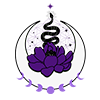How to Treat Anxiety with CBT
Cognitive behavioral therapy (CBT) has become the leading treatment for anxiety, and with good reason. Research indicates that CBT can be an effective treatment for anxiety after as few as 8 sessions, with or without any form of medication (4). CBT is a popular and effective form of psychological treatment. The key message of CBT is that the way we think (our cognitions) and what we do (our behavior) affects the way we feel.
It follows that if we want to change the way we feel then we will need to make changes to the way we think and act.
We have minds that are very ready to notice cause and effect. There are examples all around us: if we let go of an object it will fall to the floor; if we press a switch a light comes on; if we pour water on something then it becomes wet. If you watch very young children exploring their world you can see them learning about the effects of their actions. By the time we’re a bit older the rule of cause and effect has become so natural to us that it just feels like common sense.
There is a problem though: this simple cause-and-effect way of thinking doesn’t work very well when we apply it to our feelings. Our ‘common sense’ way of thinking about the world tells us that it is situations that make us feel a certain way.
The insight of the CBT model is that it is not events that bother us. Instead, it is the way that we interpret events – the meaning that we give to them – that gives rise to our feelings. This explains why twenty people experiencing the same event can react in completely different ways.

Theory
CBT works by identifying and addressing how a person’s thoughts and behaviors interact to create anxiety. As an Empowerment Coach, I work with my clients to recognize how negative thought patterns influence a person’s feelings and behaviors. This article aims to explore these therapeutic practices to help you gain more control over your reactions.
Here’s an example of how two different people can react to a situation differently based upon their thoughts:
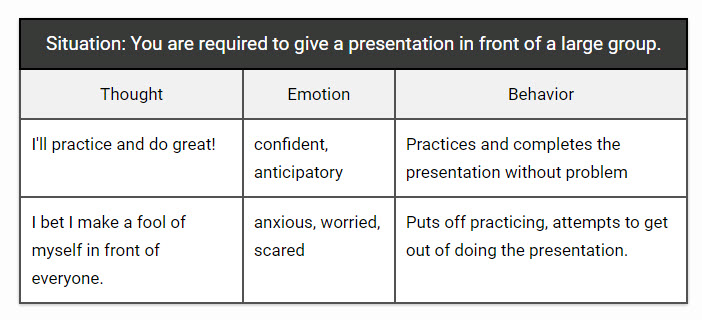
With CBT, you can be trained to intervene by changing negative thought patterns, utilizing relaxation skills, and learning how to change behaviors that lead to the problem worsening.
Treating Anxiety with CBT
Anxiety Psychoeducation
Getting to the root of your anxiety is a process and it beings by exploring your triggers, or sources of anxiety. What are the situations when you feel most anxious? What do you think, and how do you respond in these situations? How is it affecting you life?
Anxiety is a feeling of intense discomfort, which drives people to avoid the feared stimuli. Anxiety is defined by avoidance. It’s important to understand that every time they avoid an anxiety-producing situation, their anxiety will be even worse the next time around.
The brain sees it like this: “When I avoid this situation, I feel better. I guess I should try to avoid it next time too.”
Look at this graph to help visualize how it works:
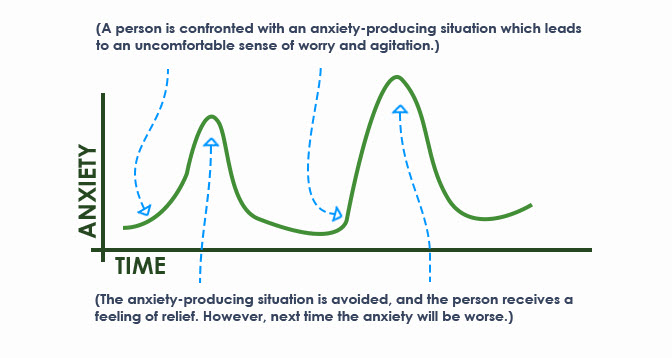
The Yerkes-Dodson law states that too little or too much anxiety are both harmful, and that a person reaches optimal performance on a task with a moderate level of anxiety.
Someone who has no anxiety has little motivation to keep up with their responsibilities and someone with too much anxiety will attempt to avoid the situation, or perform poorly due to their symptoms. However, someone with a moderate level of anxiety will be motivated to prepare, concentrate, or do whatever is necessary for their particular situation without becoming debilitated or avoidant.
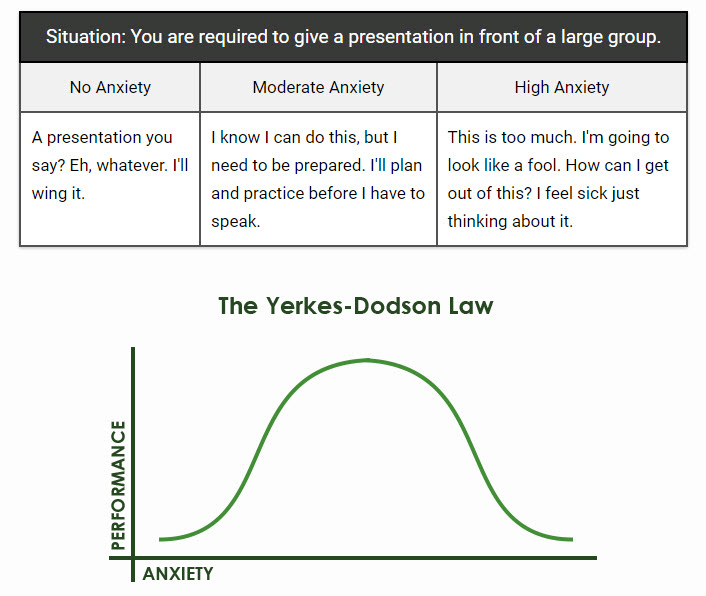
Everyone deals with their emotions differently, so you need to identify what you do when your anxious. Maybe you tap your feet, pace the floors, start sweating, become irritable, think about the situation non-stop, have insomnia, feel nauseas, bite your nails, or any type of avoidance like gaming, shopping, partying, etc. It’s important to recognize when you feel anxious, because the next step will be to challenge those automatic responses.
Challenging Negative Intrusive Thoughts
Before challenging thoughts will be effective, you need to understand the relationship between your thoughts, feelings, and behaviors.
Practice identifying your thoughts and then completing a thought log for homework. A thought log requires you to describe situations that you experience throughout your day, recording the thoughts you had during that situation, and then the resulting consequence (both a behavior and emotion). Without practice identifying how thoughts and emotions are linked, the most important thoughts will pass by unnoticed and unchallenged. In this case, you should focus on thoughts that contribute to your anxiety.
Once you have practiced identifying your negative thoughts and become somewhat proficient at recognizing them, it is time to begin challenging these thoughts. After having a thought that contributes to anxiety, ask yourself:
“Do I have evidence to support this thought, or am I making assumptions?
Do I have good reason to be anxious?”
Look at the following example:
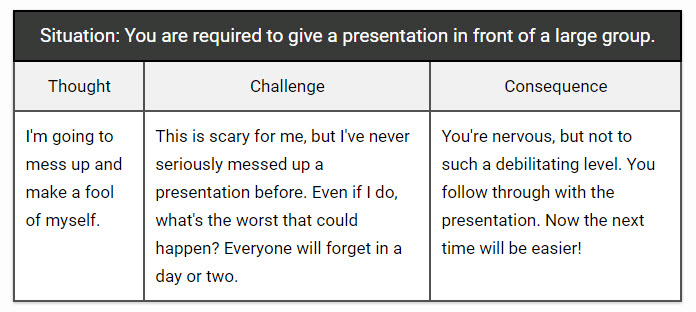
In practice, challenging long-held beliefs can be very difficult. One technique to help ease this process is for clients to ask themselves a series of questions to assess their thoughts. Here are some examples:
“Is there evidence for my thought, or am I making assumptions?”
“What’s the worst that could happen? Is that outcome likely?”
“What’s the best that could happen?”
“What’s most likely to happen?”
“Will this matter a week from now, a year from now, or five years from now?”
After successfully challenging an old belief, your client will need to replace it with a new belief. I want to emphasize that the new belief does not need to be full of sunshine, rainbows, and happiness. Sometimes, the best replacement thought is just less negative. Some situations really are scary, and denying that won’t do any good. The idea is to think neutrally rather than negatively, and to put fears into perspective. Someone suffering from extreme anxiety usually perceives a situation as more dangerous than it really is.
Relaxation Skills
Relaxation skills are techniques that allow a person to initiate a calming response within their body. Everyone has their own preferences and skills that they find work best for them, so expect some trial and error before finding the technique that fits with each client. Two of the most commonly used and effective relaxation skills are deep breathing (1) and progressive muscle relaxation (2)
Deep breathing (also known as diaphragmatic breathing) requires a client to take conscious control of their breathing. They will learn to breathe slowly using their diagram to initiate the body’s relaxation response.
There are many variations of this skill, and we’ve shared one easy-to-use method below:
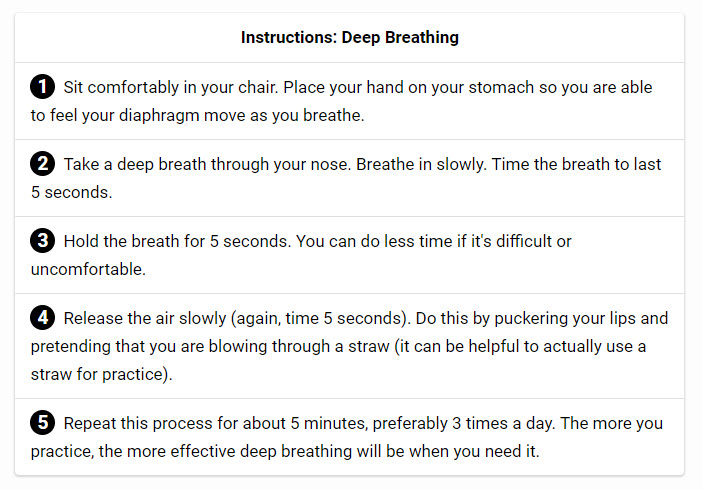
Deep breathing can be valuable in the moment when confronting something anxiety-producing, or in general as a way to reduce overall stress. It will be valuable for your clients to practice deep breathing daily even when they’re feeling fine—the effects can be long-lasting.

Progressive muscle relaxation (PMR) requires a bit more effort than deep breathing, but it can significantly reduce feelings of anxiety (2). PMR requires the user to go through a checklist of muscles that they will purposefully tense and then relax. Using this technique will create a feeling of relaxation, and it will help to teach a client to better recognize when they are experiencing anxiety by recognizing the tension in their muscles. Because the script is lengthy, we have included it in a printable format below.

References
1. Borkovec, T. D., & Costello, E. (1993). Efficacy of applied relaxation and cognitive-behavioral therapy in the treatment of generalized anxiety disorder. Journal of Consulting and Clinical Psychology, 61(4), 611-619.
2. Dolbier, C. L., & Rush, T. E. (2012). Efficacy of abbreviated progressive muscle relaxation in a high-stress college sample. International Journal of Stress Management, 19(1), 48-68.
3. Kessler R. C., Chiu W. T., Demler O., & Walters E. E. (2005). Prevalence, severity, and comorbidity of twelve-month DSM-IV disorders. National Comorbidity Survey Replication Archives of General Psychiatry, 62(6), 617-27.
4. Stewart, R. E., & Chambless, D. L. (2009). Cognitive-behavioral therapy for adult anxiety disorders in clinical practice: A meta-analysis of effectiveness studies. Journal of Consulting and Clinical Psychology, 77(4), 595-606.
Download Your 3 Free Resources
Get these free printable/fillable worksheets now! Learn how to challenge your negative thoughts, keep a thought record log for deeper exploration, and study the cognitive behavioral model for greater insight.
